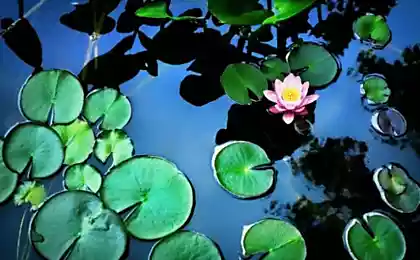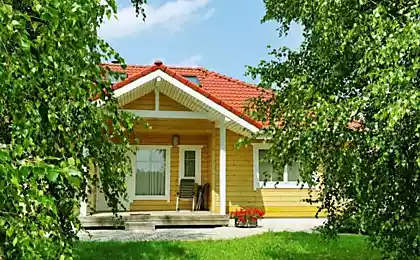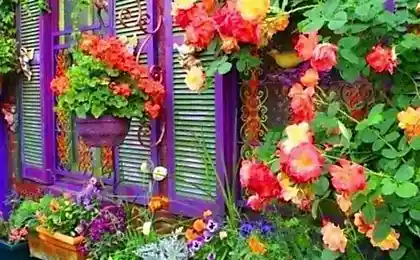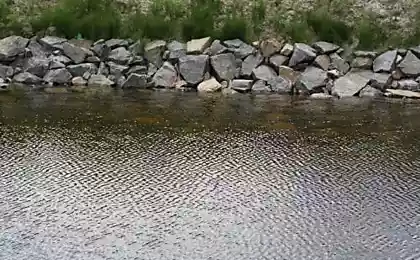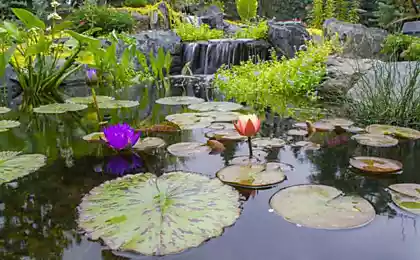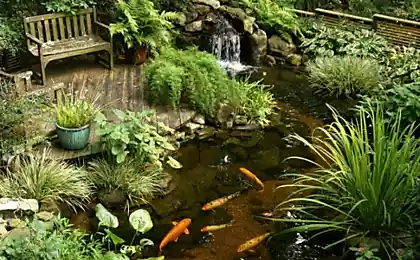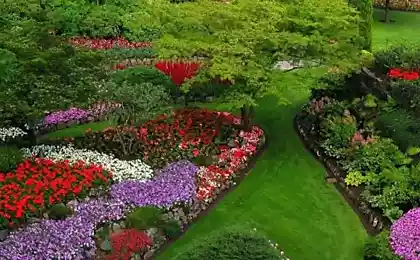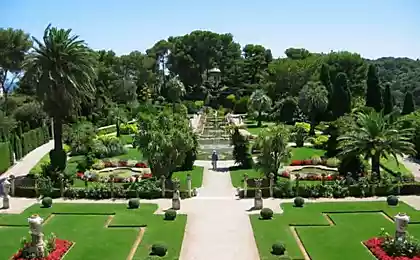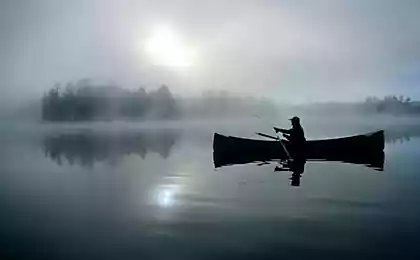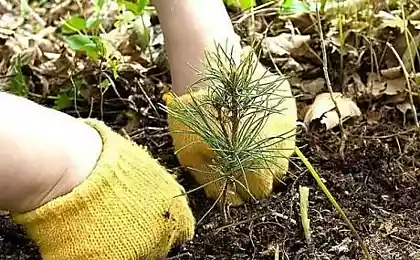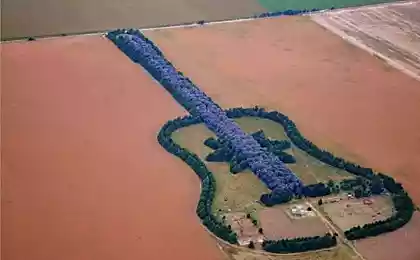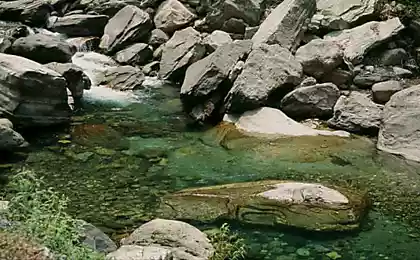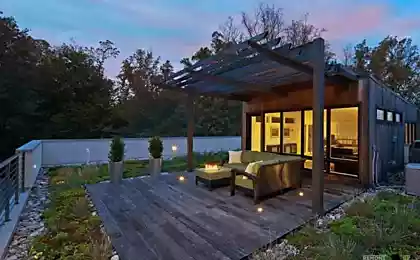301
10 best perennials for the design of the reservoir
The beginning of June is a great time for planting aquatic plants, and therefore it is time to talk about which plants are better to choose for the design of the pond, so that it corresponds to the style of your cottage.
Hybrid water lilies (Nymphaea) No other plant can compare with the beauty of nymphs or water lilies – one of the most beautiful aquatic plants. These are white wild water lilies from natural reservoirs, and varietal nymphies with large, 15-20 cm diameter flowers of a variety of colors: white, pink, yellow, raspberry. They bloom in June-September. Water lilies appeared on sale a few years ago, but still in the beauty of aquatic plants are not inferior to anyone their palm. The water lilies give the pond a touching, nostalgic flair and perfectly fit into the design of the dacha both in the romantic style and in the Art Nouveau style.
Features of cultivation.It is recommended for the deep-sea zone of the reservoir, when planting large plants at a depth of 50 cm or more, small ones - from 20 cm, preferably in a thick layer of organic silt or on fertile heavy clay soil.
It's interesting.. In ancient times, blue nymphae flowers, called the Egyptian blue rose, decorated the halls of rulers, religious buildings and dwellings in the land of the pharaohs. In ancient Greece, the water lilies flower was a symbol of beauty and eloquence. There is a legend about nymphs that turned into a flower of a white water lily and lured travelers to the bottom. Among the Slavs, the water lilies were endowed with mystical and therapeutic powers. It was called a viper-grass and believed that it is able to overcome all evil and ailments. In addition, she helped travelers, softened the hearts of cruel beauties, endowed talents.
About the water lilies of the hybrid on the site can still be read in the article Late flowering in the pond.
Ordinary, or swamp (Acorus calamus) Air forms spectacular groups, rising high above the water stems and leaves of a serpentine shape with a spicy, pleasant smell. The strict linearity of the plant harmoniously fits into the regular style of the cottage, and into its landscape image. Supports and creates a greenish-white (Variegatus form) gamut. Decorative in any phase of development. It is recommended for the design of various reservoirs as a focal plant. Planting air, you can provide the family not only with valuable food and medicinal raw materials, but also keep clean water in the reservoir.
Features of cultivation.Air is planted with immersion in water to a depth of 0.3-0.5 m or with planting in a wetland zone, preferably on clay, but it is also possible on sandy soil, permissible - in containers (for the winter, the leaves are cut, leaving 10 cm above the water surface). It grows long in one place. With intensive growth, it is able to displace other plant species; control of distribution is required. Distance between plants 50-70 cm.
That's interesting.Air, like the water lilies, is also shrouded in legends and legends. It is believed that it was brought from the south during the Mongol-Tatar invasion. It was the Eastern warriors who threw it into reservoirs, and if the plants took root, the water was considered clean and suitable for drinking.
You can read more about aira swamp on the site in the article Collect and use the roots of aira.
Iris is arivoid or marsh (Iris pseudacorus) A very spectacular aquatic plant from the family of iris, or orasthic, quickly forming groups of juicy greens. During the flowering period brings its sunny joyful chords, proclaiming the triumph of life. It grows up to 90 cm high, on one rhizome - 12-15 bright yellow flowers that bloom in late May - July. Sword leaves up to 120 cm long are decorative throughout the summer.
Features of cultivation.They land in shallow water. It is necessary to control the spread of rhizome. It is better to plant in a container and annually remove sprouts growing to the sides. At the end of summer, all the leaves are cut off so as not to clog the banks and bottom of the reservoir.
That's interesting.In the Middle Ages, iris became a Christian symbol, personifying the sufferings of the Virgin, and at the turn of the XIX-XX centuries - one of the flowers of the Art Nouveau style.
White porch, or calla marsh (Calla palustris) A beautiful exotic aquatic plant from the aroid family, especially spectacular during flowering. Natural habitats are shallow waters along the banks of overgrown ponds. Thick fleshy rhizome grows quickly, the plant in one summer can completely cover an area of several square meters. Beautiful her heart-shaped, dark green, shiny leaves. Inflorescences with a white blanket appear in May-June. By the end of summer, bright red fruits are formed. Suitable for water bodies dacha in modern style. Flowers are used in cutting, they look very beautiful and majestic in bouquets, symbolizing freshness and purity.
Features of cultivation.Depth of landing of calla 10-15 cm. Multiply with rhizome segments. The leaves are cut for the winter. It is better to plant the calla in a container, which is brought to the basement for the winter and stored until the onset of stable spring warm weather.
In the southern regions in the ponds are more often used relative of the calla marsh – Ethiopian or Zantedeschia Ethiopian (Zantedeschia aethiopica). If the tubers are dug in the fall (they are stored at a temperature of 10-15 °) and not too fast (after the last spring frosts) planting in the spring, this plant can be grown even in the reservoirs of central Russia. On the Black Sea coast of the Krasnodar Territory and the southern coast of the Crimea, you can leave zantedesiya to winter in open ground near the water in secluded areas of the dacha, protected from cold northern winds, covering it with leaves. Since May, the Ethiopian Calla blooms abundantly for a long time.
You can read about the white-winger on the website this material is also White-winger or swamp stool, and about Ethiopian calla, its cultivation, varieties, care - Kalla is a beautiful tropic woman in the garden.
Rogoz (Typha)
All rogoses are beautiful background perennial plants. It is recommended to create spectacular thickets in large reservoirs, and in small ones they are planted in small groups or alone. Rogoses look harmoniously in the waters of landscape style dachas. Their dense, dark brown inflorescences with a velvety surface bloom in June-August.
Features of cultivation. The minimum depth of plant placement in the reservoir is 7-12 cm. Distribution control is required; it is better to plant in a container. At the same time, excess rhizomes should be removed to prevent growth.
That's interesting.I'm sure many of you know a rogoz called "reed" However, this reed is a completely different plant from the sedge family, with wide blizzards at the ends of long stems. You'll read about him below. Why this happened is not known for certain.
About the rogoz on the site you can still read the material Rogoz narrow-leaved and broad-leaved rogoz - a beautiful duo in the pond of the dacha.
Reed of the Lake (Scirpus lacustris) That was the reed noise. This large plant from the sedge family with loose texture is better to decorate quite large reservoirs in mass groups. When greening small bodies of water can be used by small groups planted in containers to limit the area of food and, therefore, the growth of plants. Long stem grows up to 1-2 m high, and the leaves of the reed are barely noticeable, narrow, small, located at the inflorescence-blizzard.
Features of cultivation.It is better to plant in containers in the zone of shallow water at a depth of 7-12 cm. Winters in the water.
It's interesting.. Not only can the water be decorated with reeds, it is also suitable for food. Its rhizomes are edible - fresh, baked, crushed and boiled, from dried rhizomes you can make flour. You can also eat the root part of the stem of young plants, juicy and sweet to taste. People who find themselves in extreme conditions are not threatened with hunger when there is a reed nearby.
The common reed (Phragmites communis, syn. P. australis) The cane belongs to the family of mints (so that reeds, rogoz, and reeds belonging to different families should not be confused). The cane is more suitable for the design of large reservoirs in landscape style dachas. It is decorative throughout its growth, and even the dry plants in the frozen pond, covered in snow, fascinate with its beauty. Reduces water pollution by organic substances (oxygenator).
The cane has long, erect, zizo-green stems-solomins up to 3-4 m high. Flowers in brown-purple spikelets-blizzards are small, nondescript, bloom from July to autumn. In August-September, they turn into attention-grabbing silver-drilled fluffy sultans. There is a decorative variety of cane 'Variegata' - up to 1 m high, leaves with golden yellow, later white border.
Features of cultivation.It can be planted to a depth of 1.5 m, the variegated form of 'Variegata' - 7-12 cm or in the coastal humid zone. It is necessary to control the spread, because the plant is large, powerful, forming thickets. Winters in the open.
That's interesting.The Latin name for the reed – Phragmites – comes from the Greek word phragma, which means weave, fence. And this is not accidental, because since ancient times it was used to cover roofs, fences, weaving baskets.
About the reed on the site you can still read in the article Reed ordinary - protector of the reservoir.
Susak umbrella (Butomus umbellatus) A very elegant plant for the design of ponds, capable of emphasizing both a strict regular style of composition with its sleek, long leaves, and naturally fit into the company of aquatic plants of the pond in a landscape style. The height of the stems at the susak is 40-10 cm, the flowers are pink and white, collected in umbrellas, bloom in June-July.
Features of cultivation. Susau can be planted in a container in shallow water (10 cm to 1 m). He prefers clay soil. It grows rapidly; it is divided every 2-3 years. Distribution control is required.
That's interesting.The Latin name of the susaka – Butomus – comes from the Greek words bus – bull, tomnein – to pinch and speaks of susaka as a forage plant for cattle.
About the umbrella on the site, see more material here.
Arrow-leafed or common (Sagittaria sagittifolia) The strelolist is one of the most beautiful aquatic plants, stands out with decorative leaves of different shapes (depending on their location) and white with dark purple or pink flowers in the brushes on trihedral stems. It blooms in July and August. Suitable for water bodies of cottages made in various styles: both regular, landscape and eclectic.
Features of cultivation. It can grow at different depths: from 20-60 or more (up to 120 cm). The shooter is unpretentious to the ground, grows well on a moist bottom.
Plantaceous Frequent (Alisma plantago-aquatica) This is an excellent decorative, in flowering - openwork plant with a beautiful Latin name is great for decorating water bodies in landscape or landscape style. Sprawling rosettes of leaves look great along the shore. The stem with flowers reaches a height of 60-80 cm, the flowers in the snowstorm are small, white or pink, bloom in June-September.
Features of cultivation.You can plant in shallow water with a depth of 15-30 cm. The distance between plants is 40-50 cm.
About the frequency of plantain on the site you can still read the article If in your pond grows a lot of plantain or alisma.
Source: www.7dach.ru
Hybrid water lilies (Nymphaea) No other plant can compare with the beauty of nymphs or water lilies – one of the most beautiful aquatic plants. These are white wild water lilies from natural reservoirs, and varietal nymphies with large, 15-20 cm diameter flowers of a variety of colors: white, pink, yellow, raspberry. They bloom in June-September. Water lilies appeared on sale a few years ago, but still in the beauty of aquatic plants are not inferior to anyone their palm. The water lilies give the pond a touching, nostalgic flair and perfectly fit into the design of the dacha both in the romantic style and in the Art Nouveau style.
Features of cultivation.It is recommended for the deep-sea zone of the reservoir, when planting large plants at a depth of 50 cm or more, small ones - from 20 cm, preferably in a thick layer of organic silt or on fertile heavy clay soil.
It's interesting.. In ancient times, blue nymphae flowers, called the Egyptian blue rose, decorated the halls of rulers, religious buildings and dwellings in the land of the pharaohs. In ancient Greece, the water lilies flower was a symbol of beauty and eloquence. There is a legend about nymphs that turned into a flower of a white water lily and lured travelers to the bottom. Among the Slavs, the water lilies were endowed with mystical and therapeutic powers. It was called a viper-grass and believed that it is able to overcome all evil and ailments. In addition, she helped travelers, softened the hearts of cruel beauties, endowed talents.
About the water lilies of the hybrid on the site can still be read in the article Late flowering in the pond.
Ordinary, or swamp (Acorus calamus) Air forms spectacular groups, rising high above the water stems and leaves of a serpentine shape with a spicy, pleasant smell. The strict linearity of the plant harmoniously fits into the regular style of the cottage, and into its landscape image. Supports and creates a greenish-white (Variegatus form) gamut. Decorative in any phase of development. It is recommended for the design of various reservoirs as a focal plant. Planting air, you can provide the family not only with valuable food and medicinal raw materials, but also keep clean water in the reservoir.
Features of cultivation.Air is planted with immersion in water to a depth of 0.3-0.5 m or with planting in a wetland zone, preferably on clay, but it is also possible on sandy soil, permissible - in containers (for the winter, the leaves are cut, leaving 10 cm above the water surface). It grows long in one place. With intensive growth, it is able to displace other plant species; control of distribution is required. Distance between plants 50-70 cm.
That's interesting.Air, like the water lilies, is also shrouded in legends and legends. It is believed that it was brought from the south during the Mongol-Tatar invasion. It was the Eastern warriors who threw it into reservoirs, and if the plants took root, the water was considered clean and suitable for drinking.
You can read more about aira swamp on the site in the article Collect and use the roots of aira.
Iris is arivoid or marsh (Iris pseudacorus) A very spectacular aquatic plant from the family of iris, or orasthic, quickly forming groups of juicy greens. During the flowering period brings its sunny joyful chords, proclaiming the triumph of life. It grows up to 90 cm high, on one rhizome - 12-15 bright yellow flowers that bloom in late May - July. Sword leaves up to 120 cm long are decorative throughout the summer.
Features of cultivation.They land in shallow water. It is necessary to control the spread of rhizome. It is better to plant in a container and annually remove sprouts growing to the sides. At the end of summer, all the leaves are cut off so as not to clog the banks and bottom of the reservoir.
That's interesting.In the Middle Ages, iris became a Christian symbol, personifying the sufferings of the Virgin, and at the turn of the XIX-XX centuries - one of the flowers of the Art Nouveau style.
White porch, or calla marsh (Calla palustris) A beautiful exotic aquatic plant from the aroid family, especially spectacular during flowering. Natural habitats are shallow waters along the banks of overgrown ponds. Thick fleshy rhizome grows quickly, the plant in one summer can completely cover an area of several square meters. Beautiful her heart-shaped, dark green, shiny leaves. Inflorescences with a white blanket appear in May-June. By the end of summer, bright red fruits are formed. Suitable for water bodies dacha in modern style. Flowers are used in cutting, they look very beautiful and majestic in bouquets, symbolizing freshness and purity.
Features of cultivation.Depth of landing of calla 10-15 cm. Multiply with rhizome segments. The leaves are cut for the winter. It is better to plant the calla in a container, which is brought to the basement for the winter and stored until the onset of stable spring warm weather.
In the southern regions in the ponds are more often used relative of the calla marsh – Ethiopian or Zantedeschia Ethiopian (Zantedeschia aethiopica). If the tubers are dug in the fall (they are stored at a temperature of 10-15 °) and not too fast (after the last spring frosts) planting in the spring, this plant can be grown even in the reservoirs of central Russia. On the Black Sea coast of the Krasnodar Territory and the southern coast of the Crimea, you can leave zantedesiya to winter in open ground near the water in secluded areas of the dacha, protected from cold northern winds, covering it with leaves. Since May, the Ethiopian Calla blooms abundantly for a long time.
You can read about the white-winger on the website this material is also White-winger or swamp stool, and about Ethiopian calla, its cultivation, varieties, care - Kalla is a beautiful tropic woman in the garden.
Rogoz (Typha)
All rogoses are beautiful background perennial plants. It is recommended to create spectacular thickets in large reservoirs, and in small ones they are planted in small groups or alone. Rogoses look harmoniously in the waters of landscape style dachas. Their dense, dark brown inflorescences with a velvety surface bloom in June-August.
Features of cultivation. The minimum depth of plant placement in the reservoir is 7-12 cm. Distribution control is required; it is better to plant in a container. At the same time, excess rhizomes should be removed to prevent growth.
That's interesting.I'm sure many of you know a rogoz called "reed" However, this reed is a completely different plant from the sedge family, with wide blizzards at the ends of long stems. You'll read about him below. Why this happened is not known for certain.
About the rogoz on the site you can still read the material Rogoz narrow-leaved and broad-leaved rogoz - a beautiful duo in the pond of the dacha.
Reed of the Lake (Scirpus lacustris) That was the reed noise. This large plant from the sedge family with loose texture is better to decorate quite large reservoirs in mass groups. When greening small bodies of water can be used by small groups planted in containers to limit the area of food and, therefore, the growth of plants. Long stem grows up to 1-2 m high, and the leaves of the reed are barely noticeable, narrow, small, located at the inflorescence-blizzard.
Features of cultivation.It is better to plant in containers in the zone of shallow water at a depth of 7-12 cm. Winters in the water.
It's interesting.. Not only can the water be decorated with reeds, it is also suitable for food. Its rhizomes are edible - fresh, baked, crushed and boiled, from dried rhizomes you can make flour. You can also eat the root part of the stem of young plants, juicy and sweet to taste. People who find themselves in extreme conditions are not threatened with hunger when there is a reed nearby.
The common reed (Phragmites communis, syn. P. australis) The cane belongs to the family of mints (so that reeds, rogoz, and reeds belonging to different families should not be confused). The cane is more suitable for the design of large reservoirs in landscape style dachas. It is decorative throughout its growth, and even the dry plants in the frozen pond, covered in snow, fascinate with its beauty. Reduces water pollution by organic substances (oxygenator).
The cane has long, erect, zizo-green stems-solomins up to 3-4 m high. Flowers in brown-purple spikelets-blizzards are small, nondescript, bloom from July to autumn. In August-September, they turn into attention-grabbing silver-drilled fluffy sultans. There is a decorative variety of cane 'Variegata' - up to 1 m high, leaves with golden yellow, later white border.
Features of cultivation.It can be planted to a depth of 1.5 m, the variegated form of 'Variegata' - 7-12 cm or in the coastal humid zone. It is necessary to control the spread, because the plant is large, powerful, forming thickets. Winters in the open.
That's interesting.The Latin name for the reed – Phragmites – comes from the Greek word phragma, which means weave, fence. And this is not accidental, because since ancient times it was used to cover roofs, fences, weaving baskets.
About the reed on the site you can still read in the article Reed ordinary - protector of the reservoir.
Susak umbrella (Butomus umbellatus) A very elegant plant for the design of ponds, capable of emphasizing both a strict regular style of composition with its sleek, long leaves, and naturally fit into the company of aquatic plants of the pond in a landscape style. The height of the stems at the susak is 40-10 cm, the flowers are pink and white, collected in umbrellas, bloom in June-July.
Features of cultivation. Susau can be planted in a container in shallow water (10 cm to 1 m). He prefers clay soil. It grows rapidly; it is divided every 2-3 years. Distribution control is required.
That's interesting.The Latin name of the susaka – Butomus – comes from the Greek words bus – bull, tomnein – to pinch and speaks of susaka as a forage plant for cattle.
About the umbrella on the site, see more material here.
Arrow-leafed or common (Sagittaria sagittifolia) The strelolist is one of the most beautiful aquatic plants, stands out with decorative leaves of different shapes (depending on their location) and white with dark purple or pink flowers in the brushes on trihedral stems. It blooms in July and August. Suitable for water bodies of cottages made in various styles: both regular, landscape and eclectic.
Features of cultivation. It can grow at different depths: from 20-60 or more (up to 120 cm). The shooter is unpretentious to the ground, grows well on a moist bottom.
Plantaceous Frequent (Alisma plantago-aquatica) This is an excellent decorative, in flowering - openwork plant with a beautiful Latin name is great for decorating water bodies in landscape or landscape style. Sprawling rosettes of leaves look great along the shore. The stem with flowers reaches a height of 60-80 cm, the flowers in the snowstorm are small, white or pink, bloom in June-September.
Features of cultivation.You can plant in shallow water with a depth of 15-30 cm. The distance between plants is 40-50 cm.
About the frequency of plantain on the site you can still read the article If in your pond grows a lot of plantain or alisma.
Source: www.7dach.ru
